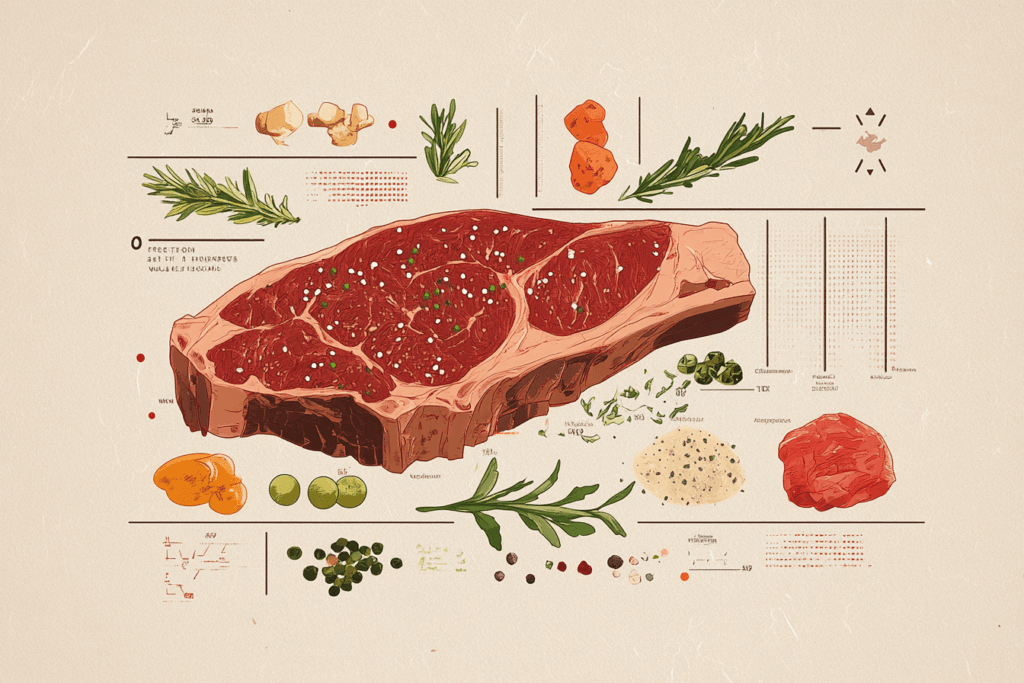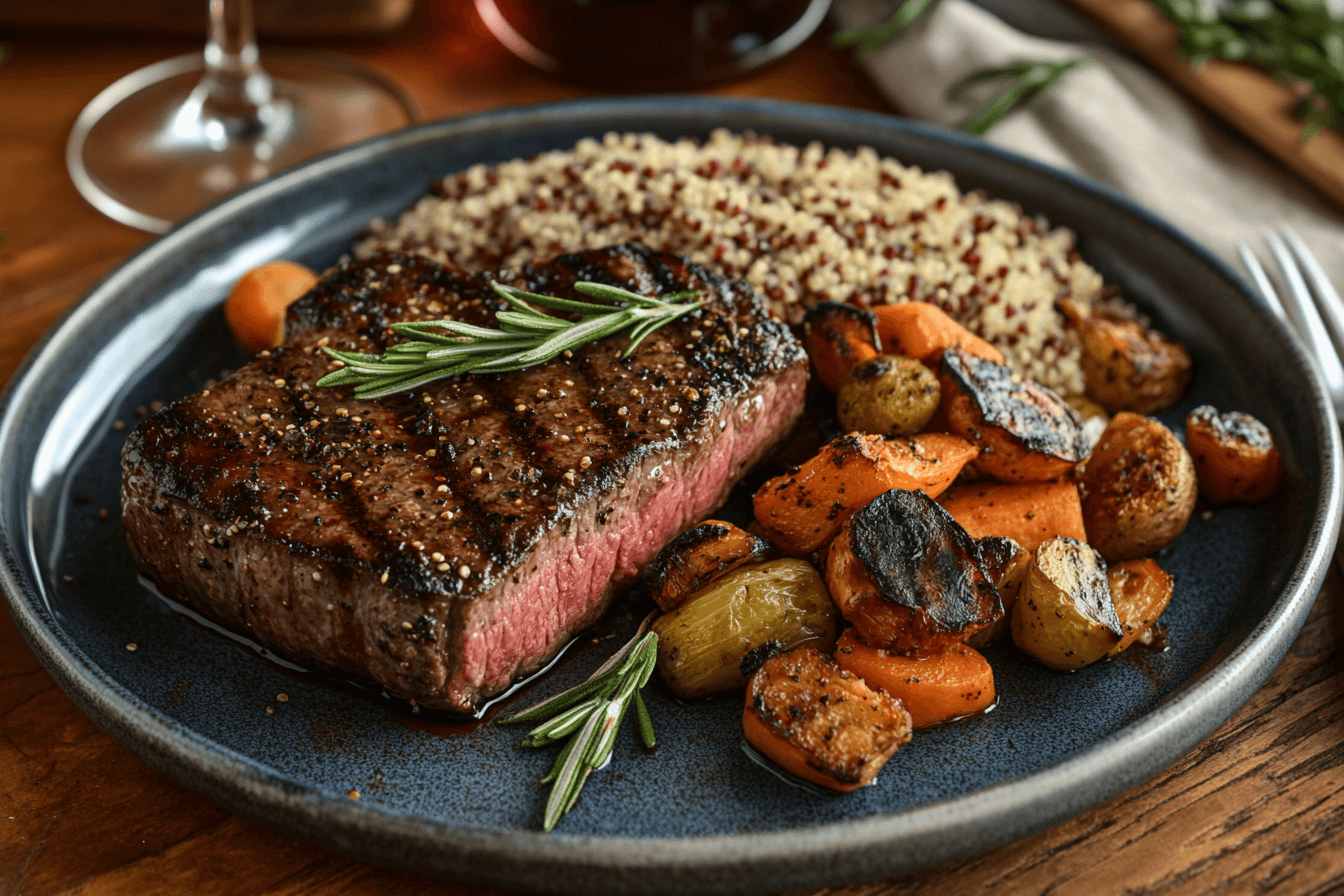Table of contents
Understanding Steak as a Nutritional Source
How many calories are in 8 0z of steak? Steak is a popular protein-rich food that offers a range of essential nutrients. Whether you’re focused on building muscle, maintaining energy levels, or simply enjoying a satisfying meal, understanding steak’s nutritional composition can help you make informed dietary choices. This guide delves into the nutrients found in steak, its protein and fat content, and its role in a balanced diet.
The Nutritional Composition of Steak

The nutritional profile of steak varies depending on the cut, preparation method, and portion size. However, here’s a general overview of what an average 3–4 ounce serving of cooked steak provides:
- Calories: 200–300 calories
- Protein: 20–30 grams
- Fats: 10–15 grams (with saturated fats around 4–6 grams)
- Iron: ~2.5 milligrams (~15% of the daily recommended intake)
- Zinc: ~4–6 milligrams (~50% of the daily recommended intake)
- Vitamin B12: ~2.5 micrograms (~100% of the daily recommended intake)
- Other Nutrients: Contains phosphorus, selenium, and small amounts of potassium and magnesium.
Steak is a nutrient-dense food, providing significant amounts of vitamins and minerals while delivering a substantial caloric value.
Protein Content in Steak
Protein is one of the most celebrated components of steak, making it a staple in diets focused on muscle repair and overall health.
- High-Quality Protein: Steak contains complete protein, meaning it has all nine essential amino acids necessary for bodily functions like muscle repair, immune support, and hormone regulation.
- Protein Density: Depending on the cut, steak provides around 7 grams of protein per ounce, making it an excellent choice for meeting daily protein needs.
- Muscle Building: The high protein content makes steak particularly beneficial for athletes, bodybuilders, and individuals recovering from injury.
Fats in Steak: Healthy and Unhealthy Types
The fat content in steak is a mix of healthy unsaturated fats and less desirable saturated fats.
Healthy Fats: How many calories are in 8 0z of steak?
- Monounsaturated Fats: Found in cuts with marbling, these fats can support heart health by improving cholesterol levels and reducing inflammation.
- Omega-3 Fatty Acids: Grass-fed beef contains higher levels of omega-3 fatty acids, which are known for their anti-inflammatory properties and benefits for brain and heart health.
Unhealthy Fats:
- Saturated Fats: Steak can be relatively high in saturated fats, especially in fattier cuts like ribeye or T-bone. Excessive saturated fat intake is linked to increased cholesterol levels and heart disease risk.
- Trans Fats: Naturally occurring trans fats in beef are minimal and not as harmful as artificial trans fats found in processed foods.
Fat Content by Cut:
- Lean cuts (e.g., sirloin, tenderloin): Lower in fat, with 4–8 grams per serving.
- Fatty cuts (e.g., ribeye, brisket): Higher in fat, with 12–16 grams per serving.
The Role of Steak in a Balanced Diet How many calories are in 8 0z of steak?
Incorporating steak into a balanced diet can be both nutritious and enjoyable when consumed in moderation and paired with complementary foods.
- Nutrient Density:
- Steak is a significant source of iron, zinc, and vitamin B12, which are vital for oxygen transport, immune health, and energy production.
- The high-quality protein in steak supports muscle maintenance and overall health.
- Portion Control:
- Aim for serving sizes of 3–4 ounces per meal to align with dietary guidelines and maintain a balanced intake of calories and fats.
- Pairing with Other Foods:
- Enhance the nutritional value of a steak meal by pairing it with fiber-rich vegetables, such as broccoli, spinach, or sweet potatoes.
- Adding whole grains like quinoa or brown rice provides additional nutrients and creates a well-rounded meal.
- Frequency:
- To balance the potential risks of red meat consumption, health organizations recommend eating steak no more than 1–2 times per week.
- Lean Choices:
- Opt for leaner cuts like sirloin or tenderloin to reduce saturated fat and calorie intake while maximizing protein and nutrients.
Conclusion
Steak is a powerhouse of nutrients, providing high-quality protein, essential vitamins, and minerals. While its fat content varies, choosing lean cuts and practicing portion control allows steak to fit seamlessly into a balanced diet. By complementing steak with nutrient-dense sides and eating it in moderation, you can enjoy its health benefits without compromising your wellness goals.
Calorie Breakdown of an 8 oz Steak
An 8-ounce steak can be a hearty and satisfying portion, but its calorie content depends on several factors, including the cut, fat content, and cooking method. Understanding these variables helps you manage your diet and make informed choices.
Calculating Calories in Different Cuts of Steak How many calories are in 8 0z of steak?
The calorie count in an 8-ounce steak varies significantly based on the type of cut. Here’s a breakdown of common steak cuts and their approximate calorie content for an 8-ounce cooked portion:
- Filet Mignon (Tenderloin): ~400 calories
- A lean and tender cut with minimal marbling, making it one of the lower-calorie steak options.
- Sirloin: ~430 calories
- A lean cut with a balance of flavor and calorie content, often considered a healthier choice.
- Ribeye: ~620 calories
- A marbled cut with higher fat content, contributing to its rich flavor and higher calorie count.
- T-Bone: ~560 calories
- Combines tenderloin and strip steak, offering a mix of lean and fatty meat.
- Flank Steak: ~480 calories
- A lean but flavorful cut, often used in dishes like fajitas or stir-fries.
- Skirt Steak: ~600 calories
- Slightly fattier and often used in marinated preparations for added flavor.
These estimates reflect grilled or broiled steaks without additional sauces or toppings.
Factors Influencing Calorie Count How many calories are in 8 0z of steak?
Several factors affect the total calorie count of an 8-ounce steak:
- Marbling (Intramuscular Fat):
- Cuts with more marbling, such as ribeye, have higher calorie content due to increased fat. Lean cuts like sirloin have fewer calories but less richness.
- Bone-In vs. Boneless:
- Bone-in steaks may weigh more but often have fewer edible ounces, slightly reducing the actual calorie intake for the same portion size.
- Trimming:
- Trimming excess fat from the steak before or after cooking can reduce calories. For example, removing the fat cap from a ribeye lowers its calorie content.
- Doneness Level:
- Cooking steak to a higher doneness level (e.g., well-done) causes more fat to render out, slightly reducing calorie content compared to rare or medium-rare steak.
- Preparation Additions:
- Butter, oil, marinades, and sauces can significantly increase the calorie count. For example, a tablespoon of butter adds about 100 calories.
Cooking Methods and Their Impact on Calories How many calories are in 8 0z of steak?
The way a steak is prepared influences its final calorie content. Here’s how different cooking methods impact the total calories:
- Grilling:
- Grilling allows fat to drip off the steak, slightly reducing its calorie content compared to other methods.
- Grilled steak often has a flavorful char that eliminates the need for calorie-heavy sauces.
- Pan-Searing:
- Cooking steak in a pan often requires added fat like oil or butter. A tablespoon of olive oil adds about 120 calories, increasing the overall calorie count.
- Broiling:
- Similar to grilling, broiling uses high heat and minimal added fat, keeping the calorie count consistent with the steak’s natural composition.
- Sous Vide:
- Cooking steak sous vide retains all the natural juices and fat, resulting in minimal calorie loss. The final calorie count depends on whether additional fat is used for searing post-cooking.
- Frying:
- Deep-frying or shallow-frying steak significantly increases calories due to the absorption of cooking oil, making it one of the least healthy options.
- Smoking:
- Smoking steak over low heat for a long duration may render some fat, but calorie changes are minimal compared to grilling or broiling.
Conclusion
The calorie count of an 8-ounce steak depends largely on the cut, preparation method, and any additional ingredients used. Lean cuts like filet mignon or sirloin are lower in calories, while marbled cuts like ribeye have a richer flavor and higher calorie content. By choosing appropriate cuts, trimming excess fat, and using healthy cooking methods like grilling or broiling, you can enjoy steak as part of a balanced diet without exceeding your caloric goals.
Comparing Steak with Other Protein Sources

When choosing protein sources, steak is often compared to options like chicken, fish, and vegetarian alternatives. Each has its own nutritional profile, calorie count, and health benefits. Understanding these differences helps you make dietary choices that align with your health goals and preferences.
Steak vs. Chicken: Calorie Comparison How many calories are in 8 0z of steak?
Steak and chicken are both excellent protein sources, but they differ in calorie content and fat composition.
- Calorie Count:
- Steak (8 oz): The calorie count varies depending on the cut:
- Lean steak (e.g., sirloin): ~430 calories
- Marbled steak (e.g., ribeye): ~620 calories
- Chicken (8 oz cooked breast): ~375 calories
- Chicken breast is naturally lean, with less fat than most steak cuts.
- Chicken thighs or legs are higher in calories (~440–500 calories for 8 oz) due to higher fat content.
- Steak (8 oz): The calorie count varies depending on the cut:
- Fat Content:
- Steak typically has more fat, including saturated fat, especially in marbled cuts like ribeye.
- Chicken breast is significantly lower in fat, making it a better option for those monitoring their fat intake.
- Protein Content:
- Steak: ~50–60 grams of protein in 8 oz.
- Chicken: ~56 grams of protein in 8 oz.
- Both are comparable in protein, but chicken may be slightly higher per ounce.
Key Takeaway:
Chicken is generally lower in calories and fat, making it a leaner option for weight management or heart health. Steak provides a richer flavor and more iron but should be consumed in moderation.
Steak vs. Fish: Nutritional Benefits and Calorie Count
Fish is another popular protein source that offers unique health benefits compared to steak.
- Calorie Count:
- Steak (8 oz): 430–620 calories, depending on the cut.
- Fish (8 oz cooked salmon): ~350 calories.
- Fatty fish like salmon have fewer calories than marbled steak cuts while providing beneficial omega-3 fatty acids.
- White Fish (e.g., cod, tilapia): ~240 calories.
- White fish is even leaner, with a lower calorie count and minimal fat.
- Nutritional Benefits:
- Steak: High in iron, zinc, and vitamin B12. It’s ideal for individuals needing more of these nutrients, such as those with anemia.
- Fish: Rich in omega-3 fatty acids, which support heart and brain health. Fatty fish like salmon or mackerel are particularly beneficial.
- White fish: Offers lean protein with very low fat, suitable for low-calorie or low-fat diets.
- Protein Content:
- Steak: ~50–60 grams of protein in 8 oz.
- Fish: ~44–50 grams of protein in 8 oz, slightly less than steak but still substantial.
Key Takeaway:
Fish, particularly fatty fish like salmon, provides unique heart and brain health benefits due to omega-3 fatty acids. It’s lower in calories than steak, making it a healthier option for some, while steak remains a richer source of iron and zinc.
Vegetarian Alternatives to Steak
For those seeking plant-based protein sources, there are several vegetarian alternatives to steak that provide comparable nutritional benefits.
- Tofu (8 oz):
- ~260 calories, ~20 grams of protein.
- Made from soybeans, tofu is a versatile and low-calorie option, especially when marinated and grilled to mimic steak.
- Tempeh (8 oz):
- ~320 calories, ~35 grams of protein.
- A fermented soy product, tempeh offers more protein than tofu and a firmer texture that works well as a steak substitute.
- Seitan (8 oz):
- ~360 calories, ~50 grams of protein.
- Made from wheat gluten, seitan is the most protein-rich vegetarian alternative and has a meat-like texture.
- Mushroom Steaks:
- Portobello mushrooms are often grilled and served as steak substitutes. While low in protein (~4 grams per 8 oz), they are low in calories (~50–60 calories) and provide a satisfying, meaty texture.
- Plant-Based Meat:
- Options like Beyond Meat or Impossible Burger patties can substitute steak. An 8 oz serving has ~400 calories and ~35 grams of protein but often includes added fats and sodium.
Key Takeaway:
Vegetarian alternatives like tofu, tempeh, and seitan are excellent protein sources that are lower in calories and fat than steak. They can be seasoned and prepared to mimic steak’s texture and flavor.
Conclusion
When comparing steak with other protein sources, each has unique advantages. Steak is nutrient-dense and flavorful but higher in calories and fat. Chicken and fish provide leaner options, with fish offering heart-healthy omega-3s. Vegetarian alternatives like tofu and seitan provide plant-based protein with fewer calories and fat, catering to dietary preferences or restrictions. Balancing these options in your diet ensures variety and nutritional adequacy.
Frequently Asked Questions About Steak and Calories
Steak is a popular food choice, but questions often arise about its calorie content, the impact of marbling, and its role in weight management. Here’s a detailed look at these common queries.
What Is the Lowest Calorie Cut of Steak?
Choosing the right cut of steak can significantly reduce calorie intake. The leanest cuts are typically lower in fat, making them ideal for those watching their calorie consumption.
- Top Sirloin: ~430 calories for 8 ounces cooked.
- A lean and flavorful option with a good protein-to-fat ratio.
- Eye of Round: ~400 calories for 8 ounces cooked.
- One of the leanest cuts, often used for roasting or slicing thinly.
- Filet Mignon (Tenderloin): ~400 calories for 8 ounces cooked.
- Though tender and considered luxurious, it has minimal marbling, keeping calories low.
- Flank Steak: ~480 calories for 8 ounces cooked.
- Slightly higher in calories but still lean and full of flavor, often used in fajitas or salads.
Key Takeaway:
Cuts like top sirloin, eye of round, and filet mignon are the best choices for lower calorie options. Preparing them with minimal added fats and oils ensures calorie count stays low.
How Does Marbling Affect Calorie Count? How many calories are in 8 0z of steak?
Marbling refers to the streaks of intramuscular fat within the steak. While it enhances flavor and tenderness, it also increases the calorie content.
- Higher Fat Content:
- Cuts with more marbling, such as ribeye or strip steak, have significantly higher fat and calorie counts. For example, an 8-ounce ribeye has about 620 calories, compared to 430 calories for an 8-ounce sirloin.
- Flavor and Texture:
- Marbling contributes to a buttery texture and rich flavor, which is why fattier cuts are often preferred for indulgent meals.
- Cooking Impact:
- Some marbled fat melts away during cooking, slightly reducing the calorie count, but the reduction is typically minimal.
Key Takeaway:
Marbling adds calories but also enhances flavor and juiciness. For a lower calorie steak, choose cuts with less marbling, like tenderloin or sirloin.
Can Eating Steak Help in Weight Management?
Steak can support weight management when consumed in moderation and as part of a balanced diet. Here’s how:
- High Protein Content:
- An 8-ounce steak provides 50–60 grams of protein, which promotes satiety and helps control hunger. Feeling fuller for longer can prevent overeating later in the day.
- Low-Carb:
- Steak is naturally low in carbohydrates, making it compatible with low-carb or keto diets aimed at weight loss.
- Nutrient Density:
- Steak is rich in essential nutrients like iron, zinc, and vitamin B12, making it a nutritionally dense food that can support overall health during weight loss.
- Portion Control:
- Choosing smaller portions or lean cuts helps manage calorie intake. A 3–4 ounce portion (about half of an 8-ounce steak) is often sufficient for a meal.
- Healthy Preparation:
- Grilling or broiling steak without high-calorie sauces or toppings ensures it remains a weight-loss-friendly option.
Potential Pitfalls: How many calories are in 8 0z of steak?
- High-Calorie Additions: Butter, creamy sauces, and rich sides can quickly add calories, negating the weight-management benefits of steak.
- Fattier Cuts: Opting for marbled cuts like ribeye may increase calorie and fat intake, which could hinder weight loss goals.
8 oz steak
Is 8 oz of steak a lot?
What does 8 oz steak mean?
Is 6 oz of steak a lot?
Key Takeaway:
Steak can aid in weight management when lean cuts are chosen, portions are controlled, and it’s paired with nutrient-dense, low-calorie sides like vegetables and whole grains.
Conclusion
The calorie content of steak depends on the cut and preparation method, with lean cuts like sirloin and tenderloin being the best options for those seeking lower calorie meals. While marbling enhances flavor, it increases calories, making it more suitable for occasional indulgence rather than regular consumption. With proper portion control and healthy preparation, steak can be part of a weight management plan while providing essential nutrients and satiety.

